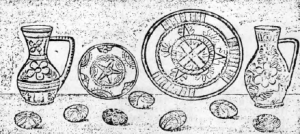Main Body
9. The Present
The majority of American-born children and grandchildren of the Romanian immigrant group today have skilled jobs. Many are in executive positions in banks, schools and industry. Today’s Clevelanders of Romanian background seem far removed from their unskilled ancestors who worked in 1905 for $1.50 a day.
Like most people of immigrant stock the Romanians, too, consider saving money a necessary virtue. While many use charge accounts, a surprising number prefer buying with cash.
Except for samples of Romanian folk art of some sort, their homes are furnished like American middle-class homes. Romanian housewives go out of their way to keep their homes painfully clean so that nobody can say, “the Romanians are not clean.”
This sort of pride is also one of the principal reasons why a poor Romanian is reluctant to apply for welfare benefits. National pride may also contribute to the lack of delinquency among Romanian youth. The social pressure of the community can not be easily disregarded by a young man or woman of Romanian background.
Intermarriage with people of other nationality backgrounds has dramatically reduced the use of the Romanian language in homes and in churches. In half of the marriages involving a Romanian, one of the marriage partners is not of Romanian origin. Consequently, the religious wedding ceremonies in all Romanian churches are conducted in both Romanian and English.
One Sunday per month, the entire Liturgy at St. Mary Romanian Orthodox church is in English. On the other three Sundays half of the service is in Romanian and half in English. Children in the Sunday school classes receive their religious education in the English language. The only prayer taught to them in Romanian is the Lord’s Prayer.
The younger generation of Romanian background takes its rightful place in the American mainstream; but to all, young and old, the center of Romanian religious and social life is the church. Long standing tradition dictates that no public or social activity be attempted without the cooperation of the church. In Transylvania and Bucovina, the original home of the first Romanian immigrants, there was no other place of importance in any village except the church.
Although here in the United States the younger generation has plenty of opportunities to form all sorts of associations, in the case of Cleveland Romanians the heart of their social life is around the church.
Any Romanian dance usually begins with the Romanian national dance, the Hora. The two Romanian orchestras in Cleveland, Jack Moga’s and John Staursky’s, have a large repertoire of Romanian melodies. A certain event may be called a Rock and Roll dance, but sometime during the evening, Romanian music must also be played.
Museum is Romanians’ Pride
By THEODORE ANDRICA
Pride of Cleveland Romanians (and of Romanians in the whole country) is the beautiful ethnographical and art museum in the educational annex of St. Mary Romanian Orthodox Church, 3256 Warren Rd.
This is the only ethnographical museum of this size of any nationality in Cleveland and the only Romanian one outside of Romania.
Peasant costumes, weavings, embroideries and wood carvings from every province of Romania and valuable rugs and paintings form the core of the 1000-piece museum collection.
In the corner of the large hall is an exact replica of a room in a peasant house in Saliste, Transylvania. The paintings include five originals by Grigorescu, Romania’s greatest painter.
Established 12 years ago, when the new building of the church and school was erected, the ethnographical and art museum was slow in developing. Its fame spread and today not only Romanians from all parts of the country but also numerous non-Romanians visit the museum.
Because there is not enough room for the collection to be placed in one room many articles, especially icons, are scattered in the various classrooms of the educational building.
“Our collection is steadily growing in size and importance and sooner or later we must find some means to enlarge the size of the museum,” Father Vasile Hategan, pastor of the church, says.
“The first important group of items in our collection came from the late Anisoara Stan, who spent 30 years traveling and collecting folk art material in Romania.
“We also inherited valuable pieces from the 1939 New York World Fair’s Romanian pavilion. The rest came from our own parishioners who not only donated the articles they inherited from their parents here and abroad but also donated the display cases.
“Outside the educational building is a large bronze statue symbolizing ‘Peace and Freedom,’ created by Oscar Hahn, a well-known Romanian sculptor.
“We are delighted to have in our museum five originals by Grigorescu, Romania’s greatest painter, and representative samples by other painters, such as Luchian.
“We are now trying to start a collection of works by Romanian artists living in the free world,” Father Hategan says.
Besides the unique museum and art collection, St. Mary’s Church boasts a library of 3000 books on Romania in the Romanian and English languages.

Taken from the Cleveland Press
February 7, 1972
The tradition which is most likely to be preserved among families of Romanian background is the preparation of Romanian food. The Ladies Aid Society of St. Mary Church published a Romanian cookbook in English. But everybody knows that the Romanian speaking housewife does not need a cookbook. She learned her art from her mother and grandmother.
Evidently the English language cookbook is used by the young, American-born generation. Within a few years, 7,000 copies of the parish’s English language cookbook were sold, principally to girls and women of Romanian background.
Clevelanders in Public Life
Many Cleveland Romanians occupy prominent places in the public life of the city.
Until just recently Ovid Corsatea was president of the Cleveland Federal Savings and Loan Company, the second largest in the city. Mrs. Virginia Barsan Peters is president of Pioneer Savings and Loan Company, the oldest Romanian financial institution in the country.
John Sibisan is vice president and attorney for the American National Bank. Savu Candea is assistant vice president and manager of the Brooklyn branch of Cleveland Federal Savings and Loan Company. Dan (Piturca) Peters and William Barsan are vice presidents of Pioneer Savings Company.
Cleveland attorneys are John Sibisan, Alex Roman, who is also mayor of Westlake, John Mihu, John Coman, who is also President of the Union and League of Romanian Societies, John Vintilla, Dan Miclau, Emil Vlad, and Nicholas A. Bucur, Jr., former Chairman of the Board of the Cleveland Transit System. Bucur is now Manager, International Trade Office, City of Cleveland.
George Dobrea, long time member and former chairman of the Cleveland School Board, is now vice president of the Greater Cleveland Growth Association for government liason.
Ralph Locher, former Mayor of Cleveland, Probate Judge of Cuyahoga County, and Supreme Court of the State of Ohio Judge-Elect, was born in Romania and speaks Romanian fluently.
Romanian physicians are Drs. Vasile Coseriu, Ana Dumitru, Lucia Trandafir (who is also an attorney), John Vidu, Mircea Catana and Dan Neagoy.
In the religious endeavor are the Very Reverend Father Vasile Hategan, pastor of St. Mary Romanian Orthodox Church; Reverend Mircea Toderich, pastor of St. Helena Romanian Byzantine Catholic Church; Reverend Father Traian Radu, pastor of Bunavestire Romanian Orthodox Church; Reverend Father Vasile Streza, pastor of Most Holy Trinity Romanian Syzantine Catholic Church; Reverend Father Virgil Parvanescu, retired Orthodox priest, and Reverend Danila Pascu, for 35 years pastor of the Romanian Baptist Church, until his retirement in 1975.
In the field of education are Nicholas Rimboi, Charles Romcea, Larissa Lucaci, Eleanor T. Romcea, Mae Latsa, Eleanor Sherb, Eleanor Musat, Fulga Pascu, Cornelia Porea Goske, Christina Podoaba, and in science, Dr. George Mateescu.
Sylvia Filip is Secretary General of the Union and League of Romanian Societies. Peter Lucaci served for the past two decades as the editor of America, the official organ of the Union and League of Romanian Societies Inc. He is also the publisher and editor of the Annual Almanac of America. During these years, Romanian Americans experienced considerable internal strife and litigation between rival factions seeking control of the Union and League. Therefore, his contributions to the preservation of the Romanian heritage in America will receive well deserved recognition only in the years to come.
Lucretia Stoica is Director of the Nationalities Services Center, a Red Feather agency dedicated to assisting immigrants in establishing themselves, finding jobs, getting their citizenship, aiding in their immigration problems, and in general, orienting themselves in the new way of life.
Theodore Andrica, author of this study, was the Nationalities Editor of the Cleveland Press for 46 years, beginning his career with the Press in 1926. Nicholas Bacaintan, recently retired, served for many years as a member of the State Department staff, stationed in various nations of Europe.
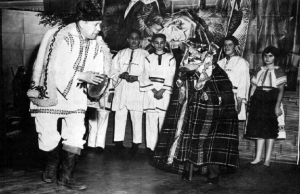
Engineers include Virgil Stanciu, John Dragos, Dan Strugar, George Poporad, Victor Constantinidis, George Benedikt and Stefan Benedikt. Peter Stoicoiu was vice president for personnel at the National Acme company. Victor Poporad is in the business of investments and finance. In business, Ted Miclau is well known.
Although not on the air presently, the Romanian Radio Hour existed for some time. Founded originally by Peter Lucaci, it was then administered by Nick Bucur. Sr., and his son. Nicholas A. Bucur, Jr., with Julie Bacaintan, Theodore Andrica, Victor Constantinidis, and Michael and Felicia Ionescu, the latter being former opera stars of Romania. Meanwhile, Reverend Danila Pascu has steadily aired a radio program of his own, of a religious nature.
Famous Romanians
Having emigrated to the United States from Transylvania and Bucovina when these lands were ruled by Hungary and Austria, it was but natural that the Romanians in America were familiar with the names of important personalities in the above provinces and not so much with names from the old Romanian kingdom.
There are some exceptions to this. Such Romanian rulers and leaders as Michael the Brave and Stephen the Great who lived in the 15th and 16th centuries are known to all Romanians regardless of their geographical background.
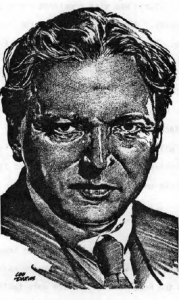
In modern times Romanians in America were visited by such well known personalities as Nicolae Iorga, the famed historian; Queen Marie, King Carol, Prince Nicholas, Princess Ileana (presently the Mother Superior of the Orthodox Convent near Ellwood City, Pennsylvania) and King Michael, and in fact, all of the Romanian royal family. They were all warmly received by Romanians and American-Romanians when they visited the various American cities, including Cleveland.
George Enescu, the world famous Romanian composer and conductor visited the United States several times. Up until the 1976 Olympics, when Nadia Comanechi thrilled the world with her perfect scores in gymnastics, the name of George Enescu was probably the best known Romanian name in the world. His scintillating Romanian Rhapsody with its brilliant bursts of melody and rhythm has brought him universal acclaim. Enescu spoke to the world in the universal language of love. His musical notes sprang from the Romanian soil, as they are founded in folk tunes, and he polished them to perfection. When he conducted the Cleveland Orchestra during his last visit to Cleveland, the audience was tremendously moved by the rendition of his own compositions. Those who recall the occasion still become emotional as they tell of the electrifying effect on the listeners, realizing that it was one of the truly great moments in musical history.
A child prodigy born in 1881 to poor farm parents, Enescu gave his first public concert in Vienna at the age of 13. In 1901 and 1902 he composed the first two Romanian Rhapsodies. He made his first concert tour in the United States in 1939, including Cleveland. His last tour was in 1946, and he died in May 1955 in Paris, a universally loved human being. His statue stands in the Romanian Cultural Garden in Cleveland, commemorating his magnificent contribution to the music of the world.
Another famous musician is Stella Roman, Romanian opera singer of the Metropolitan Opera of New York. She performed many times in Cleveland and has many friends here. Sergiu Celibidache is a world famous symphony orchestra conductor, as is Remus Tzincoca, formerly of Montreal, and now living in Romania. A well known local musician is George Poinar, who served as head of the Department of Music of Baldwin-Wallace College for many years.
All Romanians, wherever they are, take great pride in the works of the world famous Romanian sculptor, Constantin Brancusi. Many of his creations are in museums in New York, Philadelphia and Cleveland. Nicolae Grigorescu, the internationally known Romanian painter, is the best known artist among Americans of Romanian descent. Peter Neagoe was a Romanian-American writer who published, in English, several volumes on Romanian rural life and customs.
Recently, in 1973, Cleveland Romanians gave a formal reception to Nicolae Ceausescu, President of Romania, and received him cordially, putting aside the question of idealogy and emphasizing cultural exchange. On that occasion, 31 petitions to reunite families were submitted to and granted by Ceausescu.
Romanian ambassadors to the United States are frequent visitors to Cleveland. As recently as December 1976, the new ambassador to the United States, the Honorable Nicolae Nicolae, and his commercial minister, Napoleon Fodor of New York, visited Cleveland and at a seminar held at the Mid-Day Club, presented a list of programs and projects reflecting the needs of Romania, in the area of mutual trade and commerce, to an audience of business leaders of the American Romanian community.
Stella Roman in Cleveland
When the internationally known Orpheus male chorus of Cleveland will give its annual concert on April 25th, 1944, in Severance Hall, two persons chiefly responsible for the success of the concert this year will be Stella Roman of the Metropolitan Opera Company, the soloist, and Dr. Nicholas Neagoy, president of the chorus. Both are Americans of Romanian descent. The Orpheus male chorus headed this year by Dr. Neagoy is one of the best known musical organizations in the world. It was established in 1921 by Dr. Charles D. Dawe. The chorus participated several times in choral competitions in the British Isles; toured Russia at the invitation of the Russian government, and consistently won first prize in competitions in this country and abroad.
At the Orpheus chorus’ annual concerts, the soloists are singers of international reputations.
This will be Miss Roman’s third appearance in Cleveland.
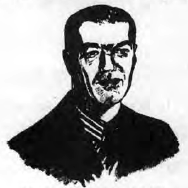
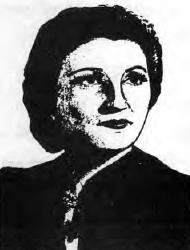
Miss Roman was born in Cluj, Transylvania and spent her childhood in Pianul de Sus, a delightful little community in Transylvania. She first studied music in Cluj, the capital of Transylvania, later in Bucharest, Vienna and Milan, making her operatic debut in 1936 at the Teatro del Corso in Bologna, Italy.
She made her American debut at the Metropolitan Opera Company in New York in “Aida” in 1941. Since then she appeared in the Metropolitan’s leading productions both in New York and on tour.
Dr. Nicholas C. Neagoy, the president of the Orpheus chorus, has been with the group five years, singing with the tenors. He served on the executive committee four years, two years ago he was elected vice preident and this year, president.
He graduated in 1933 from Western Reserve Dental School; was a charter member of the Rho Alpha Sigma college fraternity. He is a member of the Cleveland Dental Society and a director of the Cultural Association for Americans of Romanian descent.
(From “The New Pioneer,” page 28, April, 1944.)
In the business field, an unusually gracious and successful business leader is a woman, Christine Valmy, a pioneer in the “facial education” of women in the western world, and in the promulgation of modern skin care; she has established over 1000 Valmy salons across the United States. She came to the United States with $15.00 in her pocket and some ideas. She now grosses over $5 million in sales and services, according to a recent article in People Magazine.
In the entertainment field, many artists and stars either were born in Romania, or are descendants of Romanian immigrants, such as Jean Negulesco, the famous film director, Sylvia Sidney, the actress, Sue Carol (an actress who married Alan Ladd early in her career) and Edward G. Robinson. The lovely Nadia Gray has appeared in more European films than American.
The current Ambassador from the United States to Romania is the Honorable Harry Barnes, stationed in Bucuresti. Ambassador Barnes very much contradicts the negative image cast by the “Ugly American,” as he is much appreciated by the Romanians for one particular trait, among others. He speaks Romanian fluently.
Romanians everywhere received with great pride the news that the 1974 Nobel Prize for Medicine was given to a Romanian now living in New Haven, a naturalized citizen, Dr. George Emil Palade. Dr. Palade was born and educated in Romania. He came to the United States in 1946 and specialized in medicine and anatomy. He is now professor of cell biology at Yale University, where he initiated a project correlating biochemistry and morphological analysis of cell structures. In 1966 he received the Albert Lasker Basic Research Award and in 1970 the Hurwitz Prize. He is the author of many scientific papers and is an outstanding example of a Romanian immigrant who became a success in America, by virtue of his talent, hard work and persistence.
In the field of politics, among “Old Country” Romanian politicians best known to Americans of Romanian descent is the late Dr. Julius Maniu, leader of the Romanian National Peasant Party both before and after the first World War.
After the formation of Great Romania in 1918, Dr. Maniu became the head of the first Romanian provisional authority in Transylvania and later became a member of the Greater Romanian parliament. He headed the government several times. When the Communists assumed power in Romania, Dr. Maniu was imprisoned and charged with being a spy for the United States and other Western powers. He was given a life sentence and died in prison in 1951.
A savant with an international reputation in comparative religion is Mircea Eliade, historian, author and teacher. He was born in Bucuresti, Romania and received his Ph.D. in 1932 from the University of Bucuresti. He traveled widely and attended or taught at the universities of Calcutta, Sorbonne, Paris and Chicago. He has lectured in Rome, Lund, Marburg, Munich, Frankfort, Strasbourg and Padua. As a diplomat he served at London and Lisbon (as cultural attache). He is the director of the Zalmoxis[1] Research Institute, and the author of many famous books on comparative religion, including Myth and Reality, Myth of the Eternal Return, Forge and the Crucible, Patterns in Comparative Religion, Shamanism, and Zalmoxis, the Vanishing God.
The names of several church leaders are household names among Romanian-Americans. Orthodox church leader, Metropolitan Andrei Baron de Saguna, is known for his reorganization of the Romanian Orthodox Church in Transylvania during the Hungarian regime. Archbishop Miron Cristea, another Transylvanian, became the first Patriarch of Greater Romania. Bishop Policarp Morusca came to the United States to head the Romanian Orthodox diocese here, living for a while in Cleveland and later in Detroit. At the end of World War II he returned to Romania on a visit but was refused an exit visa from the Romanian government; he died in Transylvania.
To Romanian Catholics of Byzantine Rite the most familiar name is that of Archbishop Julius Hossu of Cluj, Transylvania, head of the Byzantine Rite Catholics in Romania. Along with the other Uniate bishops, Hossu was imprisoned by the Communist government after the Byzantine Rite Catholic Church was dissolved in Transylvania on December 1, 1948. Before his death in 1970 at the age of 87, Archbishop Hossu was made a cardinal “in pectore” by Pope Paul VI, thus becoming the first Romanian cardinal in the history of the Catholic Church.
In the field of sports, two names have become virtual household words — Nadia Comanechi and Ilie Nastase — in different contexts.
Although Romania did fairly well in other sports in the recent Olympics, such as boxing and soccer, the literally perfect performance of Nadia, a living doll, skyrocketed Romania’s name to the skies. She achieved seven perfect scores of 10, and captured the hearts of millions in the process. She was born in 1961 in the town of Onesti, later named Gheorge Gheorghiu-Dej. It is a town of about 40,000 near the Carpathian Mountains, some 187 miles from Bucuresti, the capital. She and her coaches, Marta and Bela Karolyi, credit not only her natural talent, but her hard work and discipline, for her phenomenal accomplishments. In a recent television show entitled “From Romania with Love, Nadia” and hosted by Flip Wilson’s natural warmth and charm, scenes of the training school were shown, and it was evident to any viewer that Nadia is the forerunner of future talent. Views of Romania such as the folk singers, the pan pipe player, and the singer, Olimpia Panciu,[2] helped create some understanding of the nation and its people.
Such is the winsome appeal of Nadia that an American of Romanian descent said at a recent meeting, “Nadia has done more for the name and reputation of Romania alone, than have all the politicians and savants of the past years.” Perhaps it is an exaggeration, but who can hear it without a tug at the heart?
On the basis of his conduct on the tennis court, one might assume that Ilie Nastase is nasty all the time. This is not the case. His antics and performance as a spoiled and sarcastic clown are part of his “act.” Sometimes his conduct is outlandish, and some would say, even indefensible; and some of his friends have a difficult time supporting him, but the fans have found him fun to watch. The public comes to see him, and that appears to be the name of the game although it is called tennis. A charming, decent and warm person, with a gift for comedy and mischief, he is also an excellent tennis player, when he puts histrionics aside. Before Nadia came along, he was the best known Romanian in the world of sports. Being the gentleman he is, he undoubtedly does not resent relinquishing center spot to the young lady. In any case, they are both held in great affection by Americans of Romanian descent.
Nationalism
In the past, formal programs at important nationality celebrations started with the “Star Spangled Banner” followed by the anthem of the country where the celebrating group originated.
Before 1918, Transylvania was under Hungarian rule and Bucovina under Austria. Since most of the Romanians in America came from these two provinces, the logical thing would have been for the Romanians to sing, besides the “Star Spangled Banner,” the anthem of either Austria or Hungary.
But the Romanians in America were too nationalistic to sing the anthems of the countries they disliked. They found a diplomatic solution by adopting a well known Romanian patriotic song as their “temporary” anthem in America. This was “Pe-al Nostru Steag e Scris Unire” which roughly translated means “On Our Flag is Written: Unity.”
After 1918, when both Transylvania and Bucovina became part of Greater Romania, Romanians in America usually sang, after the “Star Spangled Banner,” the national anthem of the Kingdom of Romania.
Because the temporary anthem played an important role in the patriotic activities of the Romanians in America, the melody and original text is included here.
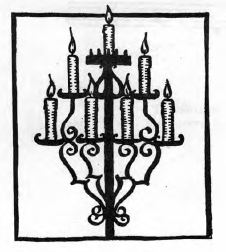
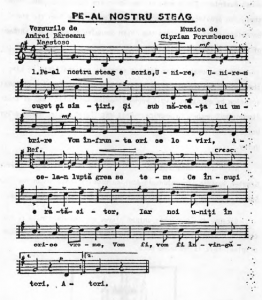
Holidays
Romanians in Cleveland and in the United States observe all the legal American holidays and, in addition, they observe the following dates, with cultural and patriotic programs:
January 24 (1859) Unification of the Romanian principalities of Muntenia and Moldova.
February 28 (1785) Austrian rulers of Transylvania put to cruel death Horia, Closca and Crisan, revolutionary leaders who fought for more rights for Romanians.
March 27 (1919) Reunification of Bessarabia (from Russia) with the Kingdom of Romania.
May 10 (1877) Romania proclaimed itself an independent kingdom (from Turkey).
November 1 (1599) Michael the Brave and his army entered Alba Iulia, historic capital Transylvania. For the first time and for a very short time afterwards the Romanian lands of Muntenia, Moldova and Transylvania were united.
November 25 (1918) Unification of Bucovina (until then under Austria) with the Kingdom of Romania.
December 1 (1918) Union of Transylvania (until then under Hungary) with the Kingdom of Romania.
December 1 (1948) Romanian Catholics of Byzantine Rite remember the suppression of their mother churches in Romania by the Romanian government.
Romanian Cooking
Among the Romanian customs and traditions to survive the longest in America is the Romanian way of cooking. In every Romanian family the American-born girls continue to learn the preparation of typical Romanian dishes, sometimes from their mothers and at times from their grandmothers.
Many parishes have issued English language Romanian cookbooks of their own with great success. The first cookbook prepared and issued by the ladies of St. Mary Romanian Orthodox Church in Cleveland has sold nearly 5,000 copies. A second and enlarged edition of this volume was published in 1975.
Most Romanian dishes can be prepared readily and economically. Following are some of the typical Romanian dishes which are still popular in American families of Romanian background.
MAMALIGA
(Corn Mush)
This national dish, the bread of the Romanian peasant, is easy to prepare, digestible, and can be served in a number of ways.
Bring one quart of water to a vigorous boil, then sprinkle in slowly two handfuls of cornmeal, stirring constantly with a wooden spoon, and cook until the mush becomes thick and smooth. Let stand on a low fire about 15 minutes longer, or until thick enough to retain the shape of the pot. With the wooden spoon first dipped in cold water press the Mamaliga away from the sides of the pot, then turn it into a wooden platter, plank or breadboard.
Mamaliga Au Gratin: Mix the Mamaliga with butter and a generous amount of cheese, spread in a buttered earthen-ware or glass casserole, cover with a layer of cheese, dot with butter and bake.
LAMB STEW WITH OKRA
1 pound lamb meat cut in pieces for stewing
1 pound fresh okra
2 Tbsp. tomato paste, thinned down in 1½ cups of water
1 onion, medium size
¼ cup butter or olive oil
juice of one lemon
salt, pepper
Wash the okra pods thoroughly and trim the stems. Be careful in doing this to avoid cutting too close so that the seeds may not be exposed. Sprinkle the pods with salt and leave them on one side to soak for ½ hour in vinegar water.
Saute the meat cubes and the chopped onion in the butter or olive oil for about 10 minutes, turing the meat about so that it may be evenly browned.
Wash the okra and add it to the lamb and onion. Pour over the thinned tomato paste and add the strained juice or a lemon. Season with salt and pepper to taste, cover and let the stew simmer gently for from ½ – ¾ hour.
GREEN PEPPER SALAD IN OIL
Sear large, fat green peppers quickly over high flame on all sides until outer skin is well charred. Be careful not to burn the pepper itself. Place in container, sprinkle with salt, cover and allow to stand for about 15 minutes. Peel and wash off outer skin, allow pepper to drain well. Arrange peppers in salad bowl with stems up, salt, add olive or salad oil and vinegar to taste. Serve cold.
CHICKEN WITH EGGPLANT
(Pui cu patlagele vinete)
1 chicken
2 or 3 eggplants
Tomato sauce
Wash eggplants, cut them lengthwise in 6 pieces, salt and place on a towel and allow to stand about ½ hour.
Cut chicken in pieces, salt and brown in hot fat; then dip the slices of eggplant in flour and brown; place eggplant and chicken in casserole and cover with tomato sauce. Allow to boil at a medium flame.
Cook the flour in shortening until brown, then add the tomatoes. Let it cook for about 5 minutes; strain and pour over the meat and eggplant. Thin the sauce with hot water so that all the ingredients in the casserole are well covered.
Preparation of the tomato sauce:
1 Tbsp. shortening
1 Tbsp. flour
1 medium can of tomatoes
MUSACA’
(Eggplant Meat Casserole)
The Romanian housewife who turns out a good Musaca’ stands high in her husband’s estimation, and her friends, for that matter. For this dish you’ll need:
2 medium eggplants
4 medium tomatoes, sliced
1 medium onion, chopped
1 small green pepper, chopped
1 Tbsp. green parsley, chopped
4 Tbsp. cooking oil or drippings
2 Tbsp. rice
1 pound ground meat (pork and veal)
1 tsp. salt
pepper if desired
Fry meat and onions in 2 tablespoons fat until juice is cooked down. Let brown stirring frequently to prevent burning. When done, set aside. Wash rice in several waters and cook for about 5 minutes. Drain, rinse in cold water and mix with meat. Slice eggplant crosswise, 1 inch thick (do not peel) and fry quickly on both sides using the remaining 2 tablespoons fat for this purpose. Use as little fat as possible adding a little at a time, while frying is done.
Arrange in casserole alternating eggplant, meat and sliced tomatoes. Begin with eggplant and finish with tomatoes. Sprinkle between layers green pepper, parsley and salt. Pour over all this 1 cup hot water. Bake 1 hour, covered, in moderate oven and ½ hour uncovered. Add a little water if needed. When done, there should be just a little juice on bottom of casserole.
MUSAKA
(Another version)
1½ pounds chopped meat
3 onions, chopped
1 tomato, cut up
3 eggplants
2 Tbsp. butter
salt, pepper, thyme
chopped parsley
2 egg whites
2 egg yolks
1 cup milk
½ cup grated cheese
6 Tbsp. crackercrumbs
¼ cup red wine
Melt the butter and brown the onions. Add the meat and stir until the meat is browned. Mix in the seasoning, the tomato and the wine. Cover, allowing the mixture to simmer gently until the liquid is absorbed.
Slice the eggplants and allow to stand, salted, for about ½ hour, then rinse and drain. Thus prepared, the eggplant slices are fried until brown.
Grease a baking dish and sprinkle the bottom and sides with crackercrumbs. Set a layer of the cooked eggplant slices on the bottom. Beat up the egg whites and mix in with the meat which has been transferred to a mixing bowl. Add 3 tablespoons of crumbs and mix well. Taste for seasoning.
Place some of this meat mixture over the layer of eggplant slices, cover with more eggplant slices and more meat alternately until the dish is filled, with eggplant slices on top. Beat the egg yolks and milk together and add the grated cheese. Pour this over the top layer of eggplant, dot with butter. Bake in a hot oven about 1 hour.
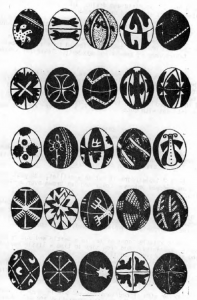
GHIVECH
(Vegetable and Meat Casserole)
Cut into pieces 2 pounds meat (beef, veal, pork, lamb); a combination of several or all may be used. Wash and salt and allow to stand for a few minutes.
Melt 2 tablespoons of fat in a skillet, add meat and 1 pound chopped onions. Cover and let brown over a slow fire.
Clean and cut in thin slices 1 carrot, 2 stalks celery, 1 parsley root, 1 parsnip. Add 1 cup of green peas, 2 green peppers cut in small pieces, ½ a small head of cabbage, coarsely chopped, 1 eggplant, cubed, and 2 cups okra.
Melt 2 tablespoons of fat in a kettle and put in the above vegetables. Add from time to time a little beef stock and allow to simmer until soft.
When the vegetables and meat are done, combine in a casserole. Add salt and pepper and chopped green parsley, and 3 or 4 thinly sliced potatoes.
Cover with sliced tomatoes and put in oven for about 1 hour, or until both meat and vegetables are well done. It may be necessary to add in the beginning some beef stock, only enough to come half way up in casserole. If beef stock is not available, use bouillon cubes.
Serve from casserole at the table.
GHIVECH
(Another version)
Carrots
Celery
Peppers
Tomatoes
Okra
Eggplant
Potatoes
Cauliflower
Green beans
Lima beans
Clove garlic
2 cups bouillon
½ cup cooking oil
Wash vegetables well and cut into large pieces. Leave okra, green beans and lima beans whole. Do not peel eggplant. Add 2 teaspoons salt, black pepper to taste and crushed garlic. Mix thoroughly and put into large casserole or roaster. Fry onions until light brown in ½ cup cooking oil, butter or drippings. Add 2 cups bouillon or water to onions and pour over vegetables. Cover and bake 1 hour in moderate oven, or until juice has cooked down.
Any vegetables may be omitted or added according to taste. Also, try broiled pork chops or lamb chops placed on top of vegetables ½ hour before done.
ROAST CHICKEN WITH TOMATOES
(Pui cu Rosii)
1 springer
4 pounds fresh tomatoes or 2 large cans
2 cloves garlic
2 Tbsp. butter
5 or 6 whole potatoes
After chicken has been cleaned, salt it and let stand for ½ hour. Brown chopped garlic slightly in butter and add tomatoes. If fresh tomatoes are used, remove skins. Bring to boil. Place chicken in roaster and add either 2 tablespoons butter or place on top a few strips of bacon and roast in moderate oven for about 1 hour. At this time, place tomatoes in, around and on top of chicken. Put salted potatoes around the chicken, cover and roast in hot oven until tender. If you want chicken well browned, remove cover during last stages of roasting.
STUFFED KALE HEAD
Parboil 1 head of kale (green cabbage may be substituted) in salt water until leaves separate.
Stuff with the following mixture: ½ pound of ground meat, ¼ cup rice, 1 egg, 1 small onion, chopped fine, salt and pepper to taste. Tie the kale and put it in a casserole. Brown 2 tablespoons shortening and 2 tablespoons flour, add 1 clove garlic, chopped fine and 3 cups water. Let simmer a few minutes and then pour over kale and bake 1 hour in a moderate oven.
SQUASH WITH DILL
Pare a small green squash and cut into thin strips. Salt and let stand 1 hour. Make a roux of 1 tablespoon butter and 1 tablespoon flour. Add the squash from which the excess moisture has been removed. Let simmer ten minutes, stirring frequently. Add 1 cup sour cream and 1 tablespoon of dill, chopped fine. Let simmer a few minutes longer.
FISH BAKED IN WHITE WINE
(Halibut, Cod, Salmon or Bass)
2 pounds fish
1 large onion, sliced
1 cup white wine
3 Tbsp. olive oil or butter
2 sliced tomatoes or 1 small can tomato sauce
½ green pepper, sliced
Pinch of powdered marjoram or summer savory
Sprinkle fish with salt and pepper to taste and cover with slices of onions. Pour wine over all and let soak for ½ hour. Melt butter in large shallow baking pan. Remove fish and onion from wine and place in baking pan, cover with tomatoes and green pepper. Bake 35 minutes in moderate oven (375°). Baste frequently with wine (in which fish was soaked) mixed with a pinch of herb. Makes 4 large or 6 smaller servings. Serve with slices of the ever present mamaliga or parsley potatoes. A green salad completes the meal.
NAVY BEAN PUREE WITH PORK SAUSAGE
(Fasole Frecata cu Carnati)
1 pound navy beans
3 Tbsp. sausage drippings
3 large onions
2 pounds pork sausage (fresh or smoked)
1 tsp. paprika
1 small clove garlic
Salt and pepper to taste
Soak beans a few hours or overnight. Drain and wash beans and put in soup kettle with water to cover beans about an inch. Add salt, pepper and crushed garlic and cook about 2 hours at moderate heat. As water cooks down, add a little hot water from time to time. When beans are done, there should be enough water to barely cover beans. Strain off water in a bowl and put beans through a sieve or strainer. Beat the puree vigorously with a wooden spoon for 1 or 2 minutes, adding a little from the strained water to give the puree the consistency of soft pudding.
While preparing beans, fry sausage ½ hour in covered skillet. Fry the coarsely sliced onions in the strained sausage drippings to light brown, add paprika and remove immediately from fire. Pour bean puree on a platter, sprinkle on top fried onions and drippings and garnish on the sides of platter with pieces of fried sausage.
In Romania the perfect accompaniment to this dish is sliced pickled cabbage with olive oil. Sauerkraut is a good substitute.
FISH STEW
3 or 4 large chopped onions
3 or 4 large sliced carrots
2 Tbsp. chopped celery
2 Tbsp. chopped parsley roots
1 green and 1 red pepper, minced
3 Tbsp. oil
2 glasses of water
2 pounds of boneless fish
salt and pepper
2 tomatoes or ½ can tomatoes
1 tsp. sugar
4 potatoes, quartered
Sauté onions, carrots, celery, parsley roots, green and red peppers in oil about 10 minutes. Add 2 glasses of water, salt, pepper, tomatoes and sugar, and cook until tender. Add fish and boil for 15 minutes. Remove from fire and let stand for about 2 hours if possible. Add potatoes which have been boiled. Reheat stew and serve in the same casserole in which it was made.
TCHORBA
Any soup seasoned with sauerkraut or pickled cucumber juice is called Ciorba or Tchorba. Very popular in Romania is:
Tchorba with Meat Balls: Mix well ½ pound of chopped veal, 1 egg, a slice of bread soaked in milk or water, salt, pepper and chopped parsley. Shape into balls the size of a walnut, roll in flour and set aside. Boil one chopped onion, one cubed carrot, and some minced parsley in a small quantity of water. When almost done, add one tablespoonful of rice and continue cooking until the rice is soft and the vegetables are tender. Cover with boiling sauerkraut juice and let come to a boil. Drop in the meat balls and add coarsely chopped parsley, fennel, celery leaves and lovage. Boil 15 minutes. In Romania it is served with a small red or green pepper, a few pits of which are used for seasoning.
NOODLES WITH CABBAGE
1 pound noodles
1 medium head of cabbage, chopped fine
salt to taste
2 Tbsp. shortening
¼ tsp. black pepper
Place noodles in boiling water and cook until tender. Chop cabbage fine, salt and let stand for about ½ hour, then squeeze until almost dry. Saute cabbage in 2 tablespoons shortening until tender, add black pepper and cook about 3 minutes. Add the noodles, mix well and serve.
STUFFED CABBAGE
(Sarmale)
This national dish is prepared usually with pickled cabbage. Fresh cabbage may be used, however.
Separate the leaves of a pickled cabbage, cutting off the hard parts. Grind and chop together 1 pound of fat pork and ½ pound of beef, add some bread soaked in water, one chopped onion, salt and pepper, and mix well to form a paste. Stir into this paste some finely chopped smoked bacon. Put a small portion of the chopped meat on each cabbage leaf, roll and tuck in the ends. The rolls should be about the size of a large walnut or slightly larger.
Arrange the rolls close together in a glazed earthenware pot after having lined the bottom of the pot with sauerkraut. Spread between the rolls thin slices of smoked bacon, dot each layer with small pieces of fat, and fill the pot with sauerkraut juice. When fresh cabbage is used, pour tomato juice over the rolls instead of cabbage juice. Let boil for 2 hours on a slow fire in a covered kettle, then uncover the pot, place in the oven and bake again on slow fire. When the cabbage is done, the liquid should be reduced to ½ the original quantity. Do not serve until the next day, then warm in the oven, adding a little liqud if necessary. Add sour cream to the sauce and serve hot. (Stuffed cabbage served with Mamaliga is excellent.)
KIDNEYS IN WHITE SAUCE WITH MAMALIGA
(Ciulama)
Clean the fat from a calf’s or pig’s kidney. Scald several times and boil until tender with soup greens, but without salt. When the kidneys are tender, prepare a white sauce as follows: Blend 2 tablespoons flour and a very little finely chopped onion. Parch but do not brown. Thin with bouillon from the kidney, add salt, and let simmer for 10 minutes or until as thick as heavy cream. In the meantime, slice the kidneys very thin, put into the sauce, and let stand without cooking. Serve very hot with Mamaliga.
CHORBA OF LAMB
(Ciorba de Miel)
1 pound of young lamb
1 onion
1 carrot
2 tomatoes
½ green pepper
parsley leaves
1 lemon
⅓ cup rice
Cut lamb in small pieces, wash and put to boil. When it starts boiling, add salt and vegetables cut into small pieces, except the parsley leaves. When the meat is almost boiled, add ⅓ cup of rice which has been cooked separately and also add the chopped parsley leaves. A few minutes before serving, break an egg in a bowl and mix well with the juice of 1 lemon; pour the chorba a little at a time over the egg and lemon juice, stirring slowly with a spoon so that the egg will not separate. Serve the chorba hot.
VEGETABLE CHOWDER
(Ciorba de Zarzavat)
1 veal shank cut in 4 pieces
¼ pound fresh green beans
¼ pound fresh wax beans (or 1 can of either cut green or wax beans)
1 green pepper
1 cup chopped cabbage
2 cups diced carrots
1 cup green peas
2 parsley roots, diced
2 parsnips, diced
2 cups diced potatoes
3 whole large onions
Boil veal shank with onions in 2 quarts water and salt to taste. Remove foam as it forms. Sauté vegetables in ¼ pound butter until tender. When veal is almost done, add vegetables and boil together until cooked well. At this time it is best to taste again for salt. Add juice of 1 lemon or more according to taste. When ready to serve, remove meat from bones and to each plate add one heaping tablespoon sour cream.
EGGPLANT SALAD
Broil an eggplant until tender. Allow to cool slightly, and then peel off the burnt skin. Chop fine with a wooden or stainless steel chopping knife. Add ½ cup olive oil, a little at a time and alternate with the juice of a lemon, meanwhile beating with a wooden spoon. Add a large onion, finely chopped, and salt and pepper to taste and chill. Serve as hors d’oeuvres accompanied by thin slices of rye bread.
GRILLED MUSHROOMS
Select large mushrooms and wash. Remove stems. Fill caps with parsley chopped fine and a little melted butter. Season with salt and pepper and broil until tender. Serve hot.
CLATITE
(Crepes Suzettes)
1 cup flour
1 egg
l½ cups milk
3 Tbsp. sugar
½ tsp. salt
2 drops vanilla
Add well beaten egg and milk to dry ingredients a little at a time and beat until smooth. Add vanilla. Four tablespoons batter should be spread over entire griddle for one suzette. Bake to a rich brown on hot, slightly greased griddle. Turn over only once. Place one on top of the other until all are baked, and keep warm. Remove one suzette at a time, spread with jelly or preserves, and roll as in a jelly roll. Sprinkle powdered sugar on top and serve.
COZONAC
(Coffee Cake)
Scald 1½ cup milk. Cool to lukewarm, add 1 cake yeast crumbled, 1 tablespoon sugar and ½ cup flour. Mix and set aside in a warm place.
Sift 6 cups flour in a large bowl and make a nest in the center. Cream 5 egg yolks with 1 cup sugar and 2 teaspoons salt in a separate bowl. When yeast is bubbling, mix with yolks and pour into nest of flour. Add grated rind of ½ lemon and grated rind of ½ orange, pinch of powdered cloves and mix. Dough should have consistency of soft bread dough. To achieve this add a little milk if needed. Beat dough vigorously (about 15 minutes) until it becomes rubbery and begins to loosen from hand and bowl. Add stiffly beaten egg whites and mix. Add ¼ pound melted butter and ¼ pound white raisins. Mix and beat five more minutes. Smooth top of dough and cover with a lid or bowl and let rise in a warm place about 2 hours.
Remove dough onto floured board. Cut in two. Roll out each piece, spread with sour cream, chopped nuts and a little sugar. Roll and braid, shaping into a round loaf. Put in well buttered and floured molds or pans, cover and let rise 1 hour. Spread top with egg yolk and bake 1 hour in moderate oven. Plum butter or a cheese filling may be used in this basic dough.
PLACHINTA
8 cups flour
3 eggs
½ pound butter
salt
warm water
Filling:
1 pound cottage cheese
½ cup sugar
6 eggs
1 grated lemon rind
salt
Sift flour, form a hollow in center of flour mound, break eggs in this hollow, add ¼ pound of butter, warm water and salt, then knead until dough blisters. Divide dough into 15 or 20 pieces in accordance with the size of the baking tin. Form dough into balls, put all pieces on floured board; cover each piece with melted butter and then cover the whole thing with a warmed pan and let it stand for 20 minutes. Grease pan with butter; stretch each ball of dough until size fits tin; place ten layers of dough, sprinkle butter between layers. Filling is prepared as follows: break eggs, separate yolks, mix yolks with cheese, sugar, lemon rind and salt; beat egg whites stiff and mix well with cheese. With half the layers in tin, add filling. Place on top of filling the rest of the dough layers. Press edge of dough with fork and bake in medium oven for 1 hour.
COTTAGE CHEESE FRITTERS
(Gogoase de Branza)
Cheese is used extensively in Romanian pastries, especially cottage cheese. The following recipe includes very little else.
1 pound dry cottage cheese
2 eggs
½ cup flour
½ tsp. salt
1 tsp. sugar
Fruit marmalade
Pinch of grated lemon rind
Put cheese through sieve. Beat well yolks with salt and sugar and mix with cheese. Add stiffly beaten whites of eggs and lemon rind and mix lightly but well. Shape dough into balls the sile of an egg and flatten slightly in moist hands. Fry quickly in well-buttered skillet on both sides. Put 1 teaspoon of any kind of fruit marmalade between two fritters and serve hot.
